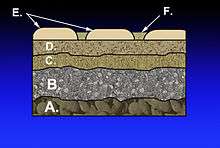Base course
The base course or basecourse in pavements is a layer of material in an asphalt roadway, race track, riding arena, or sporting field. It is located under the surface layer consisting of the wearing course and sometimes an extra binder course.

A. Subgrade
B. Subbase
C. Base course
D. Paver base as binder course
E. Pavers as wearing course
F. Fine-grained sand
If there is a sub-base course, the base course is constructed directly above this layer. Otherwise, it is built directly on top of the subgrade. Typical base course thickness ranges from 100 to 150 millimetres (4 to 6 in) and is governed by underlying layer properties. Generally consisting of a specific type of construction aggregate, it is placed by means of attentive spreading and compacting to a minimum of 95% relative compaction, thus providing the stable foundation needed to support either additional layers of aggregates or the placement of an asphalt concrete wearing course which is applied directly on top of the base course.[1][2]
Aggregate base (AB) is typically made of a recipe of mixing different sizes of crushed rock together forming the aggregate which has certain desirable properties. 20 mm or 3⁄4 in Aggregate Base, Class 2, is used in roadways and is an aggregate made of a specific recipe of different sizes and quality of rock inclusive of 20 mm (3⁄4 in) to fine dust. An aggregate is normally made from newly quarried rock, or it is sometimes allowed to be made from recycled asphalt concrete and/or Portland cement concrete.
See also
References
- Lay, M. G. (2009). Handbook of Road Technology (4 ed.). Taylor & Francis. ISBN 978-0203892534.
- Phatak, D. R.; Gite, H. K. Highway Engineering. Nirali Prakashan. ISBN 978-8185790923.